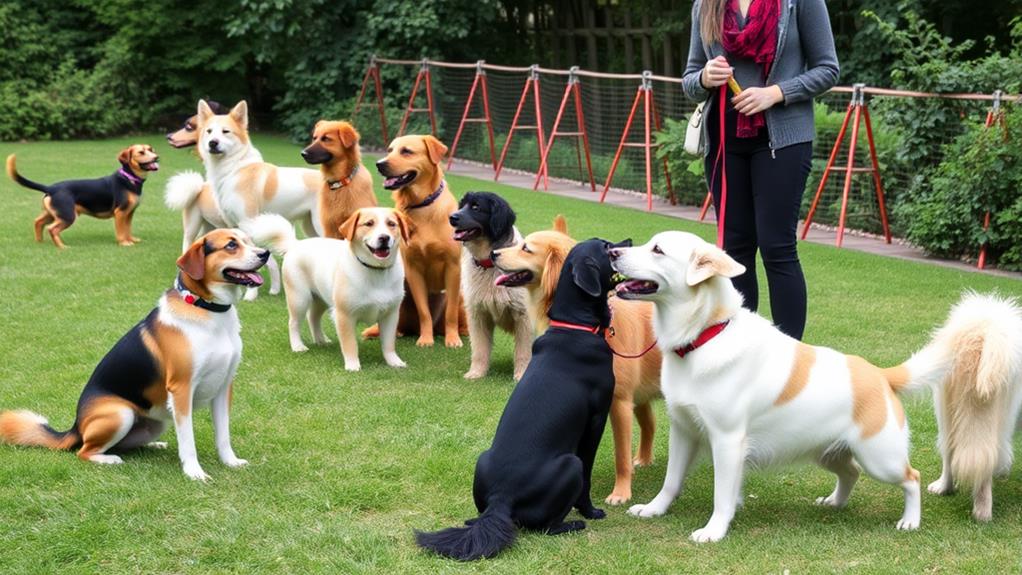To train your dog effectively, start by understanding their behavior and body language. Use consistent commands with a firm, friendly tone, and practice them regularly. Positive reinforcement is key; reward good behavior immediately with treats or praise. Socialize your dog often with different breeds to boost their confidence. Set realistic training goals and break them down into manageable steps. Remember, patience is essential, as each dog learns at their own pace. Celebrate small victories, and stay committed to their growth. There's much more to explore that can really enhance your training experience.
Understanding Your Dog's Behavior
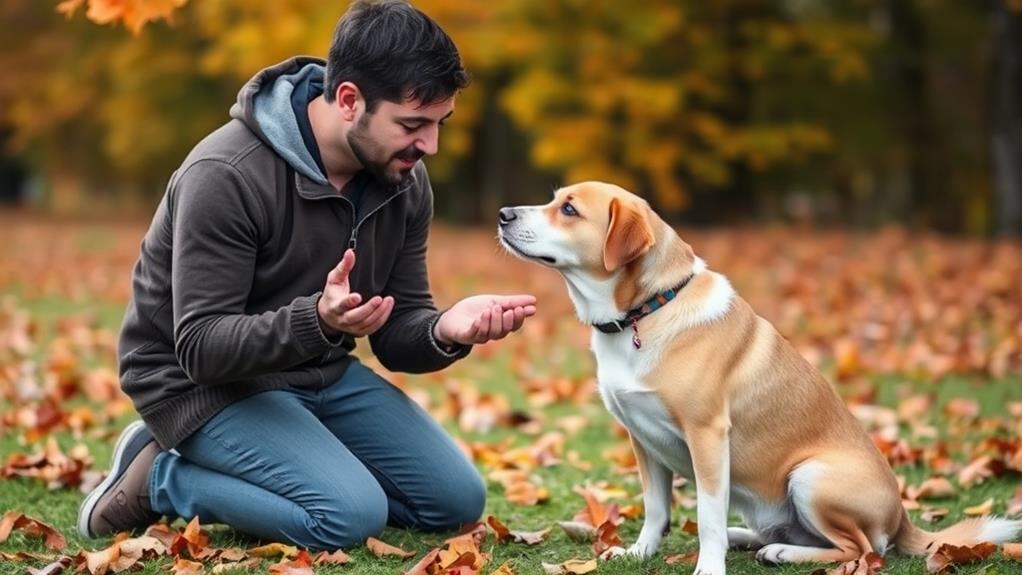
How well do you really understand your dog's behavior? Dogs communicate through a variety of signals, and recognizing these can deepen your bond. Pay attention to their body language—tail wagging can indicate excitement, while a lowered tail might suggest fear or submission. When your dog barks, consider the context; they might be alerting you to something or simply seeking attention.
Watch their ears; perked ears show curiosity, while pinned ears can indicate discomfort. Understanding your dog's behavior isn't just about deciphering their signals; it's crucial to recognize their needs. For instance, chewing might indicate boredom or anxiety.
When your dog exhibits undesired behaviors, it's imperative to assess the underlying cause instead of just reacting. Are they anxious due to changes in their environment? Are they seeking attention because they're feeling neglected?
Establishing Consistent Commands
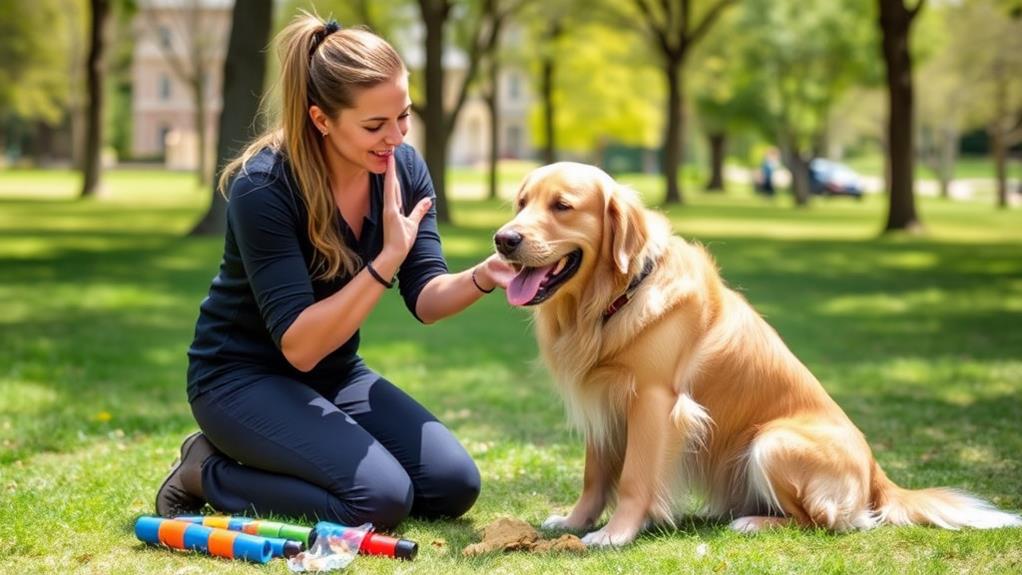
Consistency is key when it comes to training your dog. To guarantee your pup understands what you want, use the same commands every time. For example, if you choose "sit," stick with that instead of alternating between "sit down" or "sit now." This clarity helps your dog grasp what you expect.
It's also important to keep your tone steady. Dogs respond to your voice, so using a firm yet friendly tone signals that you mean business. Practice commands regularly and in various environments to help your dog adapt to distractions. This way, they'll learn to respond no matter where you are.
In addition, it's beneficial to involve everyone in your household. Ensure everyone uses the same commands and gestures. If different family members use different cues, it'll confuse your dog, making training harder.
Lastly, be patient. Establishing consistent commands takes time, and your dog may not catch on immediately. Celebrate small victories and remain positive. The more consistent you are, the more successful your training will be. Stick with it, and you'll be on your way to a well-trained, obedient dog.
Positive Reinforcement Techniques
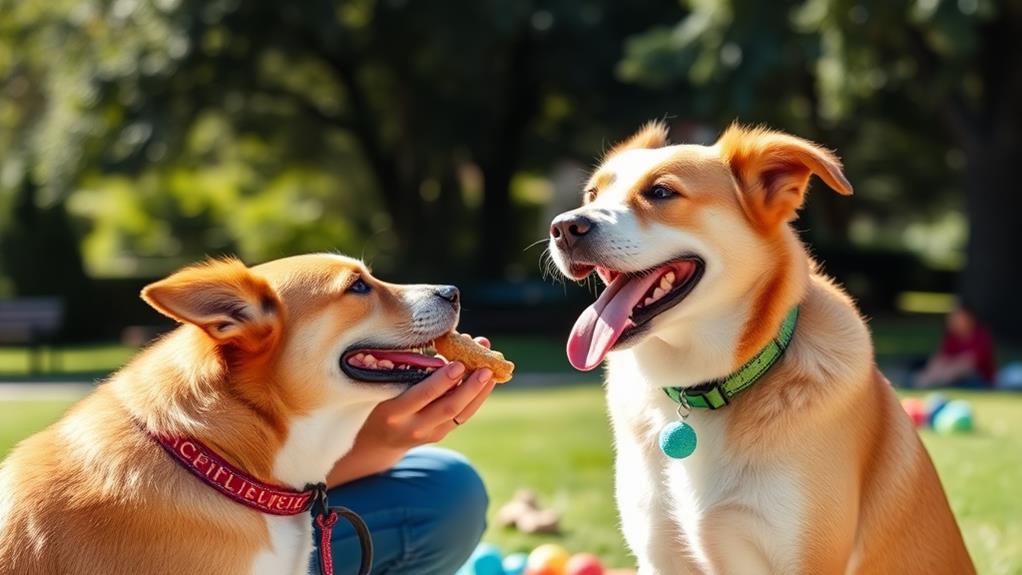
Using consistent commands lays the groundwork for effective training, but positive reinforcement is what truly motivates your dog to learn. This technique involves rewarding your dog for desired behaviors, making them more likely to repeat those actions. You can use treats, praise, or playtime as rewards, and timing is paramount. Make sure to reward your dog immediately after they perform the desired behavior so they can connect the action with the reward.
Here's a simple table to help you understand different rewards you can use:
| Reward Type | Examples |
|---|---|
| Treats | Small kibble, training treats |
| Praise | "Good boy/girl!", petting |
| Play | Fetch, tug-of-war |
Start small and gradually increase the complexity of the tasks as your dog learns. Remember, the goal is to create a positive association with training sessions. By being consistent and patient, you'll strengthen the bond with your dog while teaching them essential commands and behaviors. With positive reinforcement, you'll find your dog is enthusiastic to learn and please you!
Socialization With Other Dogs
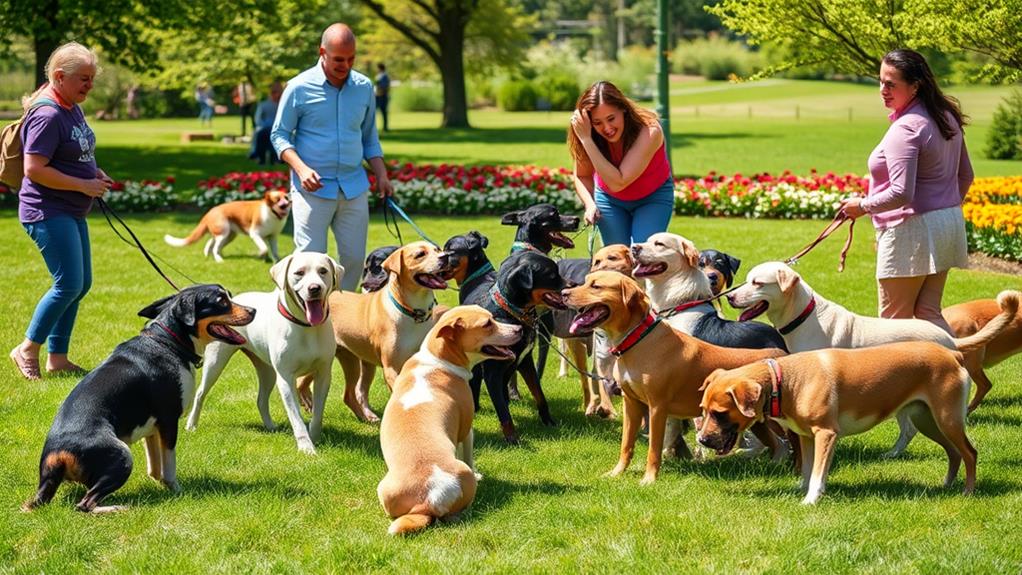
Socialization is essential for your dog's development and overall happiness. Exposing your pup to other dogs helps them learn appropriate social behaviors and reduces anxiety in new situations.
Start Early: If your dog is a puppy, aim to socialize them between 3 to 14 weeks of age. This is a critical period for learning and adapting.
Controlled Environments: Begin in a controlled setting, like a friend's yard or a dog park during off-peak hours. This allows for positive interactions without overwhelming your dog.
Positive Reinforcement: Reward your dog with treats and praise when they interact well with other dogs. This reinforces good behavior and builds confidence.
Regular Exposure: Make socialization a routine. Regular visits to parks, doggy daycare, or training classes provide opportunities for your dog to interact with different breeds and temperaments.
Setting Realistic Training Goals
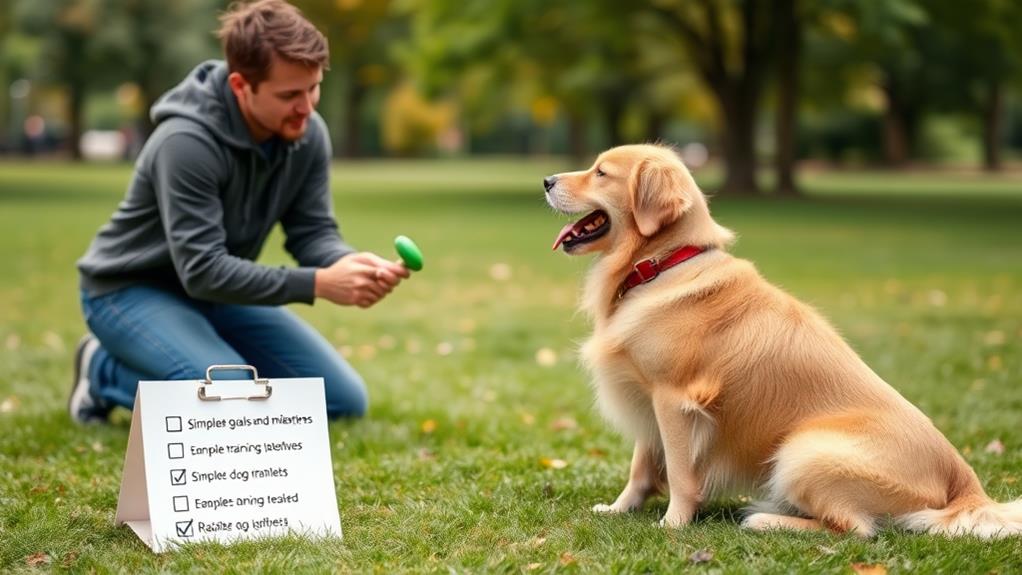
As you work on socializing your dog, it's important to set realistic training goals to guide your progress. Start by identifying specific behaviors you want to achieve. For instance, if your dog struggles with greeting new people, aim for short, controlled interactions rather than overwhelming situations.
Break down your goals into manageable steps. Instead of expecting your dog to be calm around strangers immediately, focus on smaller milestones, like encouraging calmness when someone approaches from a distance.
Make sure your goals are measurable. You might say, "My dog will sit calmly for five seconds when someone approaches." This way, you can track progress and celebrate small victories. Keep in mind your dog's age, breed, and temperament; these factors play a significant role in their learning pace.
Additionally, flexibility in your goals is key. If you notice your dog is struggling with a particular skill, reassess and adjust your expectations. Training isn't a race; it's a journey. By setting realistic goals, you'll create a positive learning environment, making training more enjoyable for both you and your dog. Remember, patience and consistency are essential as you work together towards achieving these goals.
Creating a Training Schedule
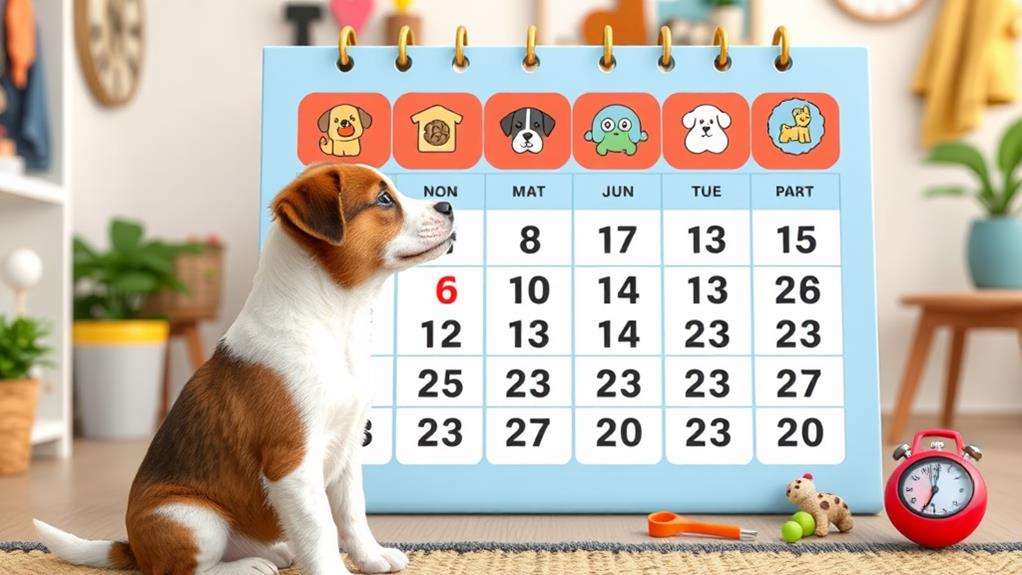
Establishing a consistent training schedule is pivotal for your dog's development. A well-structured routine helps your dog understand what to expect, making training sessions more effective and enjoyable.
Set Specific Times: Choose specific days and times for training. Consistency helps your dog learn and adapt more quickly.
Keep Sessions Short: Limit each training session to about 5-10 minutes, especially for younger dogs. This keeps their attention focused and prevents boredom.
Incorporate Variety: Mix up the activities in your training schedule. This could include different commands, tricks, or even socialization exercises with other dogs.
Be Flexible: Life can be unpredictable. If something comes up, don't stress; just adjust your schedule and get back on track as soon as possible.
Teaching Basic Commands
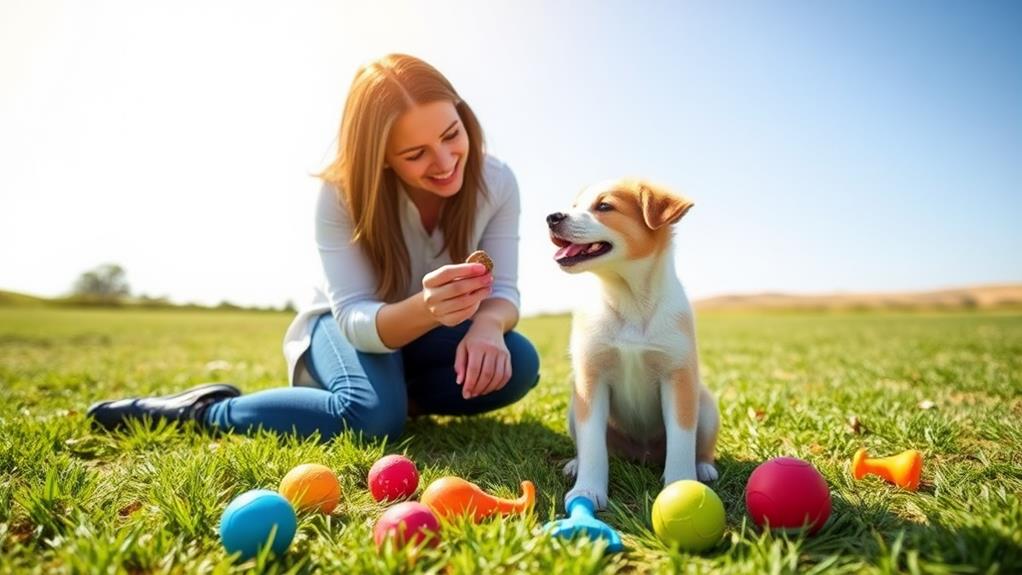
Teaching your dog basic commands is essential for effective communication and a well-behaved pet. Start with simple commands like "sit," "stay," "come," and "down." These commands form the foundation of your dog's training and help establish boundaries.
Begin training sessions in a quiet environment with minimal distractions. Use treats or toys as positive reinforcement to motivate your dog. When teaching "sit," hold a treat above your dog's nose and slowly move it back towards their tail. As their head follows the treat, their bottom will naturally lower. Once they sit, praise them immediately and offer the treat.
For "stay," have your dog sit first. Open your palm toward them and say "stay," then take a step back. If they remain in place, reward them. Gradually increase the distance and duration.
When you teach "come," use a long leash in an open space to prevent escapes. Call your dog's name followed by "come" and gently pull them towards you if they hesitate. Reward them once they reach you.
Consistency is key, so practice daily and keep sessions short and fun. With patience and repetition, your dog will master these commands in no time!
Addressing Behavioral Issues
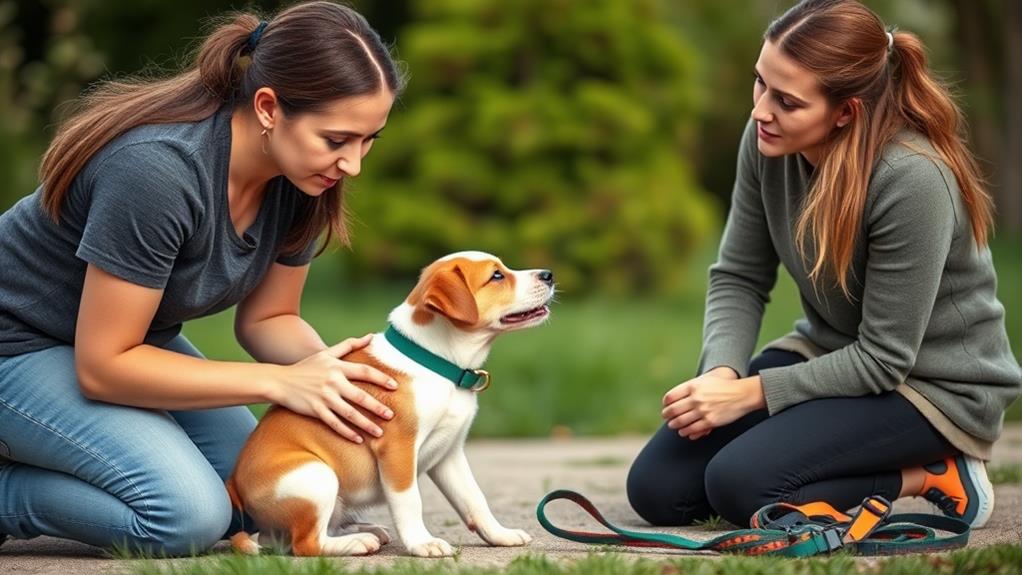
Addressing your dog's behavioral issues is essential for fostering a harmonious relationship. Every dog has quirks, but certain behaviors can become problematic if left unchecked.
Here are four common issues you might encounter and how to tackle them:
- Excessive Barking: Identify triggers and create a calm environment. Reward quiet behavior to reinforce peace.
- Jumping on People: Teach your dog to sit when greeting guests. Practice this with friends to create positive associations.
- Chewing: Provide appropriate chew toys and redirect your dog when they chew on furniture. Praise them when they choose the right item.
- Pulling on the Leash: Use a no-pull harness and practice loose-leash walking. Stop when your dog pulls, encouraging them to return to your side.
The Importance of Patience
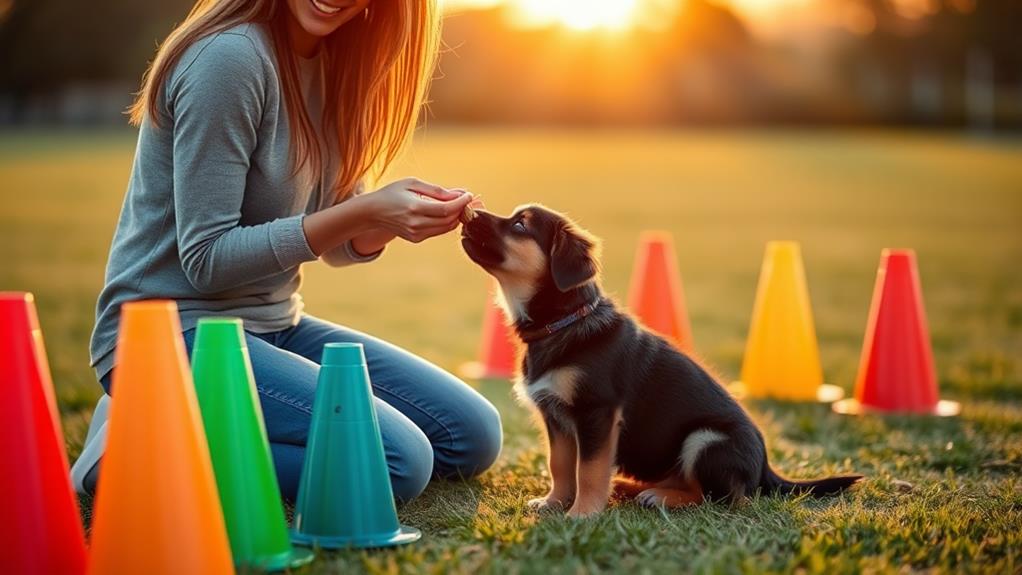
Training a dog doesn't happen overnight, and patience plays a key role in your journey. As you commence/launch/undertake this adventure, remember that each dog learns at their own pace. You might find some behaviors take longer to correct than others, and that's completely normal.
When you approach training with patience, you create a supportive environment where your dog feels safe to learn. This not only fosters trust but also encourages them to engage positively with you. If you rush through commands or become frustrated, your dog will likely sense that tension and may struggle to grasp what you're teaching.
Set realistic goals and celebrate small victories along the way. This can be as simple as your dog sitting on command or coming when called. Consistency paired with a patient attitude will yield the best results.
Also, remember that setbacks can happen. Instead of getting discouraged, take a step back and reassess your methods. Adjust your approach, and keep practicing. With time and patience, you'll both grow stronger in your bond, and your dog will become a well-behaved companion. Stay committed; the journey is worth it!
Frequently Asked Questions
How Long Should Training Sessions Last for My Dog?
Training sessions should last around 5 to 15 minutes, depending on your dog's age and attention span. Short, focused sessions keep them engaged and help reinforce learning without overwhelming them. Consistency is key!
What Are Common Mistakes Beginners Make in Dog Training?
Common mistakes you make in dog training include inconsistent commands, lack of patience, and not rewarding good behavior. Avoid distractions during sessions and always guarantee your dog understands what you expect from them.
Can I Train an Older Dog Effectively?
Yes, you can train an older dog effectively. While it might take more patience, older dogs often have better focus and experience. Use positive reinforcement, keep sessions short, and be consistent in your approach.
What Supplies Do I Need for Training My Dog?
To train your dog effectively, you'll need treats, a clicker, a leash, and a comfortable collar or harness. A designated training space and patience are essential to create a positive learning environment for your pup.
How Do I Know if My Dog Is Progressing in Training?
You'll know your dog's progressing by observing changes in behavior, responsiveness, and enthusiasm during training. Celebrate small victories, like mastering commands or showing improved focus, as these indicate your pup's growing understanding and confidence.
Conclusion
In the grand adventure of dog training, you've unveiled the secrets to a bond that could rival the greatest love stories of all time! With your newfound knowledge, you're not just a trainer; you're a canine whisperer, ready to transform your pup into the star of the dog park. Remember, every command you teach and every wagging tail you inspire is a step toward creating a legendary partnership. So grab those treats and let the magic unfold—your dog's future awaits!

